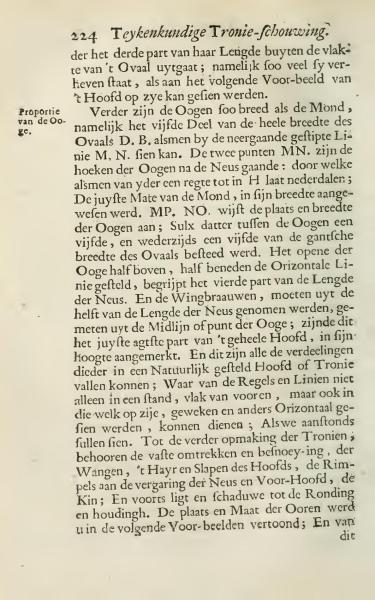Artistic Facial Sketching Observations.
...the third part of its length extends beyond the surface of the Oval; that is, as much as it appears raised, as can be imagined from the following example of the Head from the side.
Further, the Eyes are as wide as the Mouth, occupying the fifth part of the total width of the Oval D. B., as seen by the descending slanted Line M. N. The two points M. N. are the corners of the Eyes going towards the Nose: through which, when a line from each is drawn straight down to H; The correct size of the Mouth in its width is indicated. M. P. N. O. shows the position and width of the Eyes; Thus there is a fifth between the Eyes and on both sides a fifth of the entire width of the Oval is occupied. The opening of the Eye is set halfway above and below the Horizontal Line, comprising the fourth part of the length of the Nose. And the Eyebrows must be taken from half the Length of the Nose, measured from the Midline or the point of the Eye; this is exactly the eighth part of the whole Head, marked in its height. And these are all the divisions that can occur in a naturally set Head or Countenance; Where the rules and lines can serve not only in a standing position, facing forward, but also in that which retreats to the side and is set horizontally differently, as we shall see shortly. For the further arrangement of the Countenance; the fixed outlines and shaping of the Cheeks, the Hair and Temples of the Head, the Wrinkles at the junction of the Nose and Forehead, the Chin; And moreover the light and shadow up to the rounding and gesture. The position and Measurement of the Ears are shown in the following examples; And of this...
Translation Notes:
Teykenkundige Tronie-schouwing refers to detailed observations about artistic facial sketching. Tronie is an old Dutch term for a facial expression or character study, often used in art to depict unique or exaggerated features.
The text describes precise measurements and guidelines for sketching human facial features, focusing on the proportions of the eyes, mouth, and nose. It explains how different parts of the face relate geometrically to each other within an oval framework. The text also discusses how to account for the positioning and appearance of facial elements like eyebrows, cheeks, and chin, offering guidance for realistic and balanced portrait drawings.
